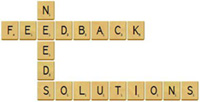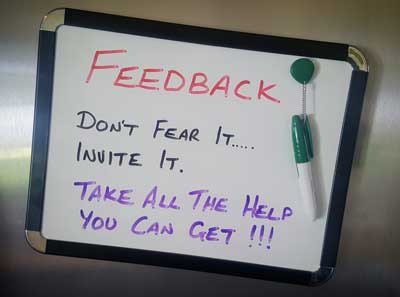![]()
 Without proactive feedback and direction from leadership, people are 'blind' and will work on their own assumptions of how they are performing to meet business needs. But feedback is a two-way street, and your entire team should not only be willing to accept feedback but actually encourage it and see the opportunity to openly discuss work topics as a critical element of the job.
Without proactive feedback and direction from leadership, people are 'blind' and will work on their own assumptions of how they are performing to meet business needs. But feedback is a two-way street, and your entire team should not only be willing to accept feedback but actually encourage it and see the opportunity to openly discuss work topics as a critical element of the job.
Regardless of whether the feedback being given is positive and complimentary or is being given to help an employee improve in certain areas, this powerful (yet very under-utilized) management tool will increase staff engagement and productivity.
Feedback in its simplest form is the act of sharing reactions to another party's actions, opinions, and behavior. What's not so simple, however, is the timing and (most importantly) the method and manner of how the message is delivered and received. In a workplace environment where openness is valued, employee feedback in a non-threatening manner should be a regular occurrence which will result in staff feeling more motivated, involved, and willing to contribute.
Feedback is not about being honest, it is about being honest skillfully
![Feedback Isn't About Being Honest]() Giving Feedback
Giving Feedback
Feedback is a powerful Leadership and Employee Engagement tool. When giving feedback, it is critical to ensure that both parties don't view it as a 'You against Me' activity but rather as an opportunity to work out an "Us against the problem(s)" plan of attack. There are no heroes or villains here...usually both parties see themselves as the hero.
To begin with, it is very important to talk about specifics rather than general traits or (even worse) your thoughts and inferences. It is perfectly fine to discuss why a product or service was sub-standard rather than simply imply that a person is not paying attention to detail.
Focus on the possible solutions to problems and issues rather than dwelling on what actually happened. State what you want to discuss and then turn the conversation into one of making things better or doing things differently going forward. Use phrases such as "What I need in the future is..." and "Next time we are faced with this, let's do..."
While we are on the topic of phrases, it is important to choose your words carefully and communicate in a certain manner. Phrases like "You should..." or "Why don't you..." will generally be perceived as you finding fault and blaming that person. A much better approach is to simply state your needs from that person, such as "I need this report each week by..." or "I'm concerned that we are not hitting our quota, so we will change and do..."
It is very important that you invite feedback from the other party. Ask them what you can do to help them, what they need to get better, or their own ideas for improvement to current practices, equipment, etc... Don't be afraid to simply ask, "What needs to happen to make what we have discussed today become a reality?"
Most importantly, when giving feedback...talk to the person and not about them.
Receiving Feedback
The first thing to remember when receiving feedback from another (whether it is your boss, subordinate, or peer) is to recognize that by coming to you, they are investing in your workplace relationship. Regardless of the underlying message, they want to help you and the rest of your team/organization be successful.
 They have come to you because they have their perception of how something has transpired, so don't dismiss this. You may not agree with the perception they have formed, but don't argue it and instead focus on trying to find out what has led them to this perception.
They have come to you because they have their perception of how something has transpired, so don't dismiss this. You may not agree with the perception they have formed, but don't argue it and instead focus on trying to find out what has led them to this perception.
You need to hear and understand the needs (and frustrations) of the person giving the feedback. Once you have done this, you should acknowledge what they have said. This does not mean you agree with their point of view, but it lets them know that their viewpoint has been heard. Phrases such as "I appreciate what you have said so let's talk in detail" or "So what you are saying is..." let them know you are intent on this being a mutually beneficial activity.
Avoid trying to deny any actions or defend/justify any outcomes that the person is trying to bring up. This gives the perception that you are not receptive to the feedback. If you can speak to specifics about the problem or issue under discussion, it will become clear to the other party where the root cause of any problem lies, and you can both work towards a solution.
Note, however, that if the person giving feedback is talking in general terms, it is perfectly ok to ask them to be more specific also.
Talk about your needs and how a solution that benefits both parties can be achieved. Tell the person what you need to be more successful and/or ask how you can work together to ensure both sets of needs will be met going forward. Stay solution-focused and concentrate on the needs of the person giving the feedback and what you can bring to the table going forward to meet these needs.
Most important when receiving feedback is to remember that a good workplace relationship requires mutual understanding and acceptance, not nondescript agreement.
Conclusion
Feedback is a very powerful method to convey the needs of individuals, teams, and the entire organization. When carried out correctly, it can give a huge boost to employee engagement and productivity..... but when poorly executed, it can lead to conflict and low morale.
In this article, we scratched the surface on what methods can be used to give or receive feedback, but ongoing activities (like those found in our online program) will really open employees to the benefits of discussing viewpoints and needs.
Remember, it's not that one view is right and the other is wrong; it is that both views matter.

 Giving Feedback
Giving Feedback